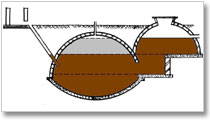AFPRO’s technical and methodological innovations are based on three basic principles:
Low-cost
As far as possible, using locally available materials
Easy to learn and carry out.
Deenbandhu 2000 Model Biogas Plants
Biogas technology is among the most underused of renewable energy sources in India. AFPRO’s work in this field has led to the development of three biogas plant models, of which the Deenbandhu (Friend of the Poor) 2000 model is the most cost effective and efficient. Chaudhri Suba Singh from Dhekoli village reports that cooking needs for his entire 15-member family are met by the 3 cubic metre plant installed in his house in 2000. The family also saves approximately Rs. 1200 in reduced consumption of chemical fertilisers – the slurry is used instead. Biogas can also be used to power halogen lamps, a boon for rural areas where electric supply is erratic.

Bamboo double leach pit sanitary latrines
The North-Eastern States of India are largely hilly tracts, where building sewerage systems is not just a costly affair, but also very difficult. Open defecation is the only way out. This pollutes the environment and leads to health problems. Constructing latrines is the only solution. But because the area gets very high rainfall, brick-and-cement structures get damaged after a few good rains, and the problem goes back to square one. With this in view, AFPRO has worked out a model that uses bamboo instead of brick to construct the leach pits.
AFPRO has held 50 training-cum-demonstrations in all seven States of North-East India. Around 500 people have learnt how to make the structures themselves. Since the method is easy to learn, the hope is that this will be the quickest method to spread the use of the model. In Renkai village, the local Pastor’s house was the first to get a bamboo leach pit latrine. Six years down the lane, he is very happy with the model. People from Renkai as well as surrounding villages have come to see the benefits from this model, and the demand is quite high. Having a latrine in the house in now considered to have a prestige value as well!

Artificial reefs in coastal waters
From the 1980s onwards, an increase in the number of mechanised trawlers have had a direct negative impact on traditional fishing communities. The trawlers sweep the seabed, seriously threatening the sustenance of the fishing resource base. Artificial reefs are a way to improve this resource base by providing the fish with a conducive environment to breed and grow. Artificial reefs are constructed from cement set in moulds. After putting them together, they are sunk off the coast in clusters of 4-5.
AFPRO’s experience with launching artificial reefs off the Nellore coast in Andhra Pradesh has shown very positive results. Traditional fishers from five villages in the area report better catches as a result of the reefs.

Comments are closed.
